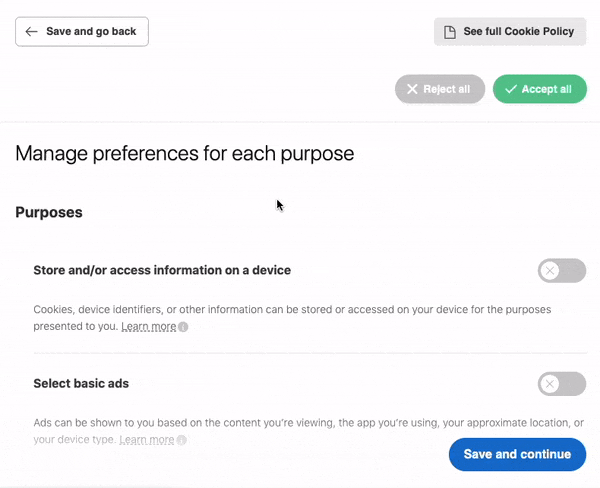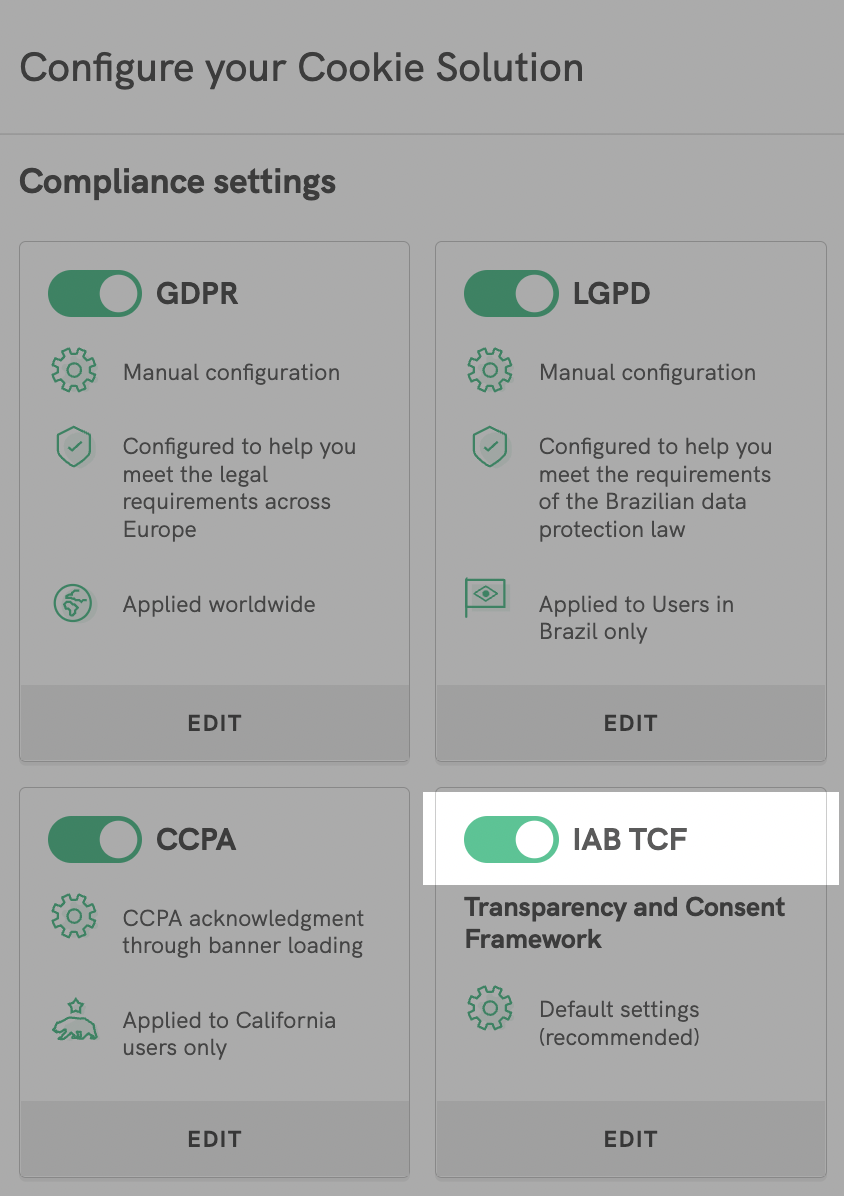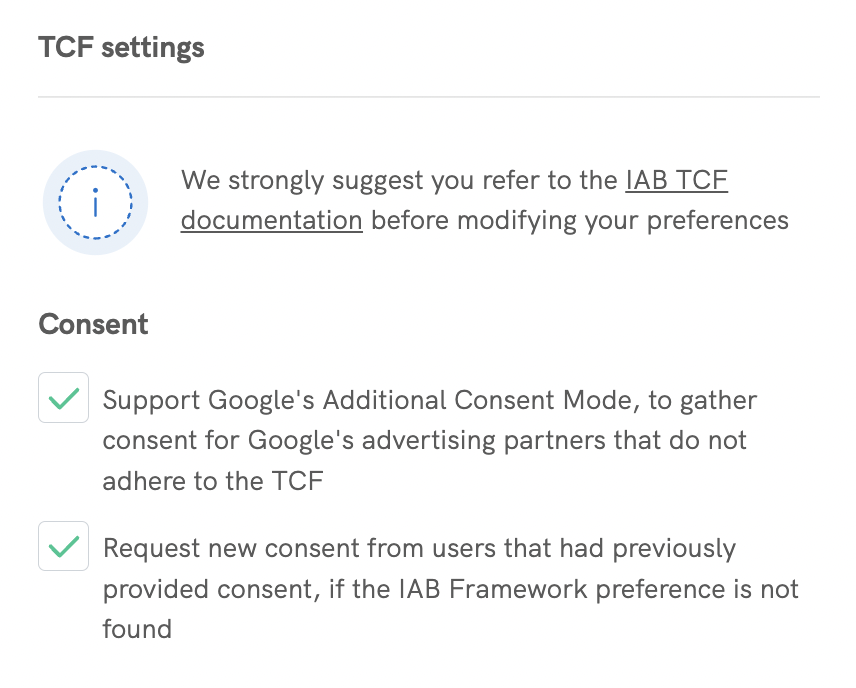TCF 2.2 has been successfully rolled out, with the implementation deadline having passed on November 20, 2023. It is crucial for Consent Management Platforms (CMPs) and Vendors to ensure they are fully compliant with the new policies and specifications. IAB Europe is actively enforcing compliance through stringent checks to maintain adherence to GDPR and ePrivacy regulations. If you need assistance, iubenda is already certified for TCF 2.2 and can guide you towards compliance. For a detailed guide on transitioning to TCF 2.2, check out this article.
This guide will help you to understand all the new features and benefits that come with the TCF v2.0 (v1.1 is no longer supported by IAB), and what action you need to take in order to make the switch.
View a live demo and have your questions answered in real time by attending our free english “Consent management for publishers” webinar. Discover in practice how you can meet both compliance and advertising industry requirements while ensuring that your ad-reach is maximized.
Attend our free webinarTCF 2.0 includes increased functionality, across various aspects of the Framework, for both consumers & publishers. The main changes are listed below.
Do keep in mind that the following information is only relevant if you have the TCF setting enabled within your Privacy Controls and Cookie Solution.
The v2 banner text has been made significantly longer to meet IAB’s requirements. The additional text contains essential disclosures related to the enhanced options that we mention in the sections below.

While the legal basis of legitimate interest has always been enabled by default, now, the right to object * (to processing based on legitimate interest) is also included as a checkbox directly within the TCF interface.
As with most of our features, you have full customization control and can choose to:
* On the right to object: Within the TCF, when a user objects using the dedicated checkbox, the objection is handled similarly to a withdrawal/rejection of consent and registered immediately. Therefore, no manual action is required on your part as the Publisher.
googleAdsPreferenceManagement is no longer supported in v2 (however, it will stay supported in v1 for as long as v1 is supported by IAB). Separate Google ad personalization settings are no longer needed (or supported) as Google has officially integrated TCF 2.0 and is now included on the global vendor list.
Any modifications you’ve made to your AdSense and Publisher Tag accounts to support the separate Google Ads preference management settings should be undone as they are no longer needed and are now redundant.
You may now benefit from more fine-tuned control over the behavior of the TCF functionality. Specifically, you can now:

PurposeOneTreatmentenableCMP replaced by enableTcfenableCMP boolean within the Privacy Controls and Cookie Solution is now enableTCF. In general, this doesn’t directly affect you as all parameters and settings that use enableCMP have been automatically updated to support the new name. Furthermore, as enableCMP is integrated with TCF v1, it will remain supported for as long as v1 is supported by IAB.💡 You can try the new configuration options yourself here
In order to make the transition:
In the Privacy Controls and Cookie Solution configurator, enable the “IAB TCF” Transparency and Consent Framework tab

and ensure that when you click “Edit” the consent checkboxes are checked: “Support Google’s Additional Consent Mode, to gather consent for Google’s advertising partners that do not adhere to the TCF”; and “Request new consent from users that had previously provided consent, if the IAB Framework preference is not found”.

This will add "tcfVersion": 2 and update the stub.js script on your Privacy Controls and Cookie Solution snippet. For example:
<script type="text/javascript">
...
_iub.csConfiguration = {
"lang": "en",
"siteId": XXXXXX, //use your siteId
"cookiePolicyId": YYYYYY, //use your cookiePolicyId
"enableTcf": true,
"tcfVersion": 2,
...
};
</script>
<script type="text/javascript" src="//cdn.iubenda.com/cs/tcf/stub-v2.js"></script>
<script>...</script>
In addition, if you’ve enabled the synchronous activator option (required if you’re not directly blocking the vendor scripts), you’ll notice that the safe-tcf.js script will be replaced by safe-tcf-v2.js
If you had Google ads personalization set up on your site and made modifications to support it, please undo these modifications as they are now obsolete (as mentioned above, Google has now integrated TCF 2.0).
Remember that from August 15th 2020, TCF v1.1 will no longer be supported by The Interactive Advertising Bureau (IAB). This means that if you haven’t switched to TCF v2 settings, your set-up will be unsupported, potentially negatively affecting your ad revenue. iubenda will continue to support v1.1 alongside v2 until this time.
You can view IAB’s transition timeline here.
💡 Please note that we now fully support v2.0, and by updating your settings in the manner above, you will already be aligned with v2.0 well before the end of IAB’s transition period.
Because the banner text and some internal options have been modified for v2.0, all end-users will be served with a fresh banner on their first visit to your site (post switch-over) as legally required.
If you’ve enabled “remember consent” within the configurator, once consent is granted by a particular user, the Privacy Controls and Cookie Solutionn will remember that consent, as per usual, for up to 12 months, after which time, the user will again be served with a fresh banner.
As with all features, these settings can be customized within your Privacy Controls and Cookie Solution configurator.
If you have any questions or need help at any time, please feel free to reach out to us via chat, or at info@iubenda.com